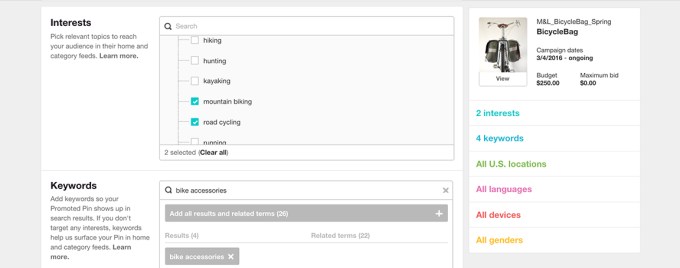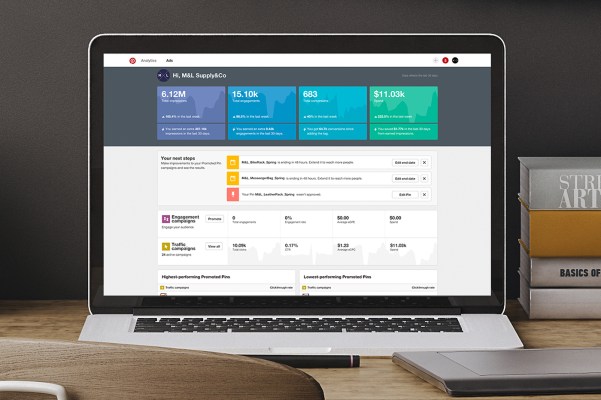Pinterest today is releasing a set of new advertising management tools that were previously unavailable for smaller businesses as its portfolio of advertising products — and revenue potential — continues to grow.
All these tools continue to give smaller and medium-sized businesses new opportunities to manage advertisements on Pinterest. Around three-fourths of the content on Pinterest comes from businesses already, and these kinds of tools help them better get the right ads in front of the right people to drive conversions. And, of course, if smaller and medium-sized businesses are buying more ads, it drives more to Pinterest’s top line.
Pinterest’s ads manager gives potential advertisers the tools that have already been available to partners for bulk-editing campaigns and more closely monitoring the success of those campaigns, as well as the ability to buy ads with a credit card to other advertisers on Pinterest as opposed to more complex mechanisms.
“First and foremost we want to build an ad platform that provides value to Pinners and is additive to the experience,” monetization product manager Nipoon Malhotra said. “We wanted to maximize the value they’re returning to partners. There’s a few other things which come into that, we’re building this for small and medium-sized businesses, wanted to make sure the platform is easy to use and is optimized for them. The results for them you see kind of speak for that.
In addition to releasing the ads manager, Pinterest is releasing some new tools for advertising targeting. First, the company is expanding the number of interests that advertisers can target against — there are now 420 of them that allow Pinterest advertisers to drill down their campaigns and make them better target potential customers. They can also target keywords in addition to interests, in the hopes of catching them at different moments in time at which they are considering purchasing things.

Malhotra expects advertisers to use a mix of all these tools in order to create better advertising campaigns. “Obviously every partner’s situation is unique but we do believe all these combinations help them maximize their impact on the platforms,” he said.
That’s important for advertisers because Pinterest users in particular are sort of wandering around the service at a wide range of moments in their lives: discovering new content, searching directly for it (which contains some level of intent that the user is looking for something to purchase), and eventually saving and potentially converting to a customer. It’s that full stack of moments in time that makes Pinterest so attractive to advertisers compared to say, Google, which is good for intent-based advertising.
“Pinners plan and discover ideas early on our platform compared to other platforms,” Malhotra said. “Christmas starts in august as opposed to December. The half-life of a pin on the platform is about [three and a half] months.”
The company is also introducing what’s called customer database targeting, in which Pinterest advertisers can upload a customer database and then use that data in order to create a profile of people they want to advertise against. They can then run campaigns against those profiles, giving them an easier way to figure out what kinds of users they want to advertise against.
Above all this, the Malhotra says the company has dedicated teams to ensure that the quality of advertisements continue to remain high as more and more advertisers have an opportunity to deploy their campaigns on Pinterest. “We’re gonna continue to invest so that Pinners are connected with the right partners,” he said. “We also have multiple teams [like engineers that work on ad relevance] inside the company [dedicated to that.]”
These tools may seem incremental at times, but all of these launches are for good reason: Pinterest only in recent years began rolling out advertising products, and has steadily been growing its revenue stream. Malhotra said that Pinterest’s revenue grew five-fold between 2014 and 2015. This one in particular, however, opens up a whole range of tools to the larger advertising ecosystem, making it one of Pinterest’s bigger ad launches.
Pinterest offers a wide array of advertising tools, ranging from ads that advertisers can pay for depending on the engagement of the pin (from expanding the size of it all the way to clicking through and making a purchase) to its own spin on video advertisements that run a short clip as users scroll down on their feeds. That’s made the platform increasingly attractive to advertisers, who have been waiting for Pinterest to give them full access and tools to manage their campaigns on Pinterest.
